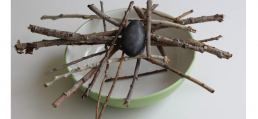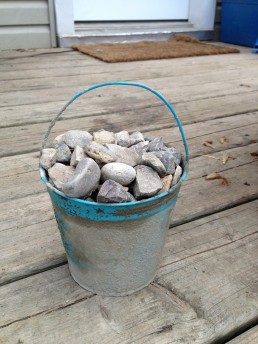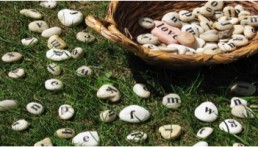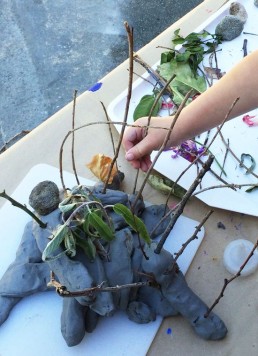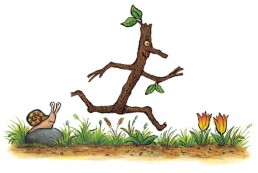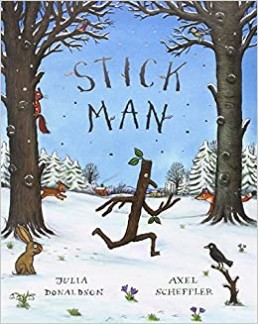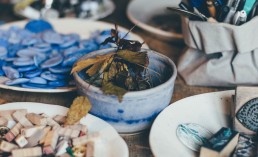Stick and Stone Balancing Activity
Resources – Sticks, a stone and a bowl
Implementation
Use your problem solving and fine motor skills to lay your sticks out and balance the stone so it doesn’t fall through into the bowl. As a challenge limit the amount of sticks and use a smaller stone!
Intent – Learning goals
Characteristics of Effective Learning
Playing and Exploring –
Being willing to ‘have a go’
- Initiating activities
- Seeking challenge
- Showing a ‘can do’ attitude
- Taking a risk, engaging in new experiences, and learning by trial and error
Active Learning –
Being involved and concentrating
- Maintaining focus on their activity for a period of time
- Showing high levels of energy, fascination
- Not easily distracted
- Paying attention to details
Keeping on trying
- Persisting with activity when challenges occur
- Showing a belief that more effort or a different approach will pay off
- Bouncing back after difficulties
Enjoying achieving what they set out to do
- Showing satisfaction in meeting their own goals
- Being proud of how they accomplished something – not just the end result
- Enjoying meeting challenges for their own sake rather than external rewards or praise
Creating and Thinking Critically
Having their own ideas
- Thinking of ideas
- Finding ways to solve problems
- Finding new ways to do things
Making links
- Making predictions
- Testing their ideas
Choosing ways to do things
- Planning, making decisions about how to approach a task, solve a problem and reach a goal
- Checking how well their activities are going
- Changing strategy as needed
- Reviewing how well the approach worked
Stone Trajectory
Throwing stones can be a great learning experience but remember to always make sure you have enough space around you so you don’t hit anyone or anything else!
Implementation
Place a bucket a short distance away from you and see if you can gently throw the stone underhand into the bucket. If this becomes easy for you then start to move the bucket a little further away. You can count how many stones you get into the bucket or you could number the stones and throw them in in order. As an extension you could have two buckets and share the stones equally between them.
 Intent- Learning Goals
Intent- Learning Goals
Trajectory Schema is an interest in lines and movement. This is a nice way to say your child keeps throwing things around the room or repeatedly dropping food from their highchair. Small babies begin to work on this schema when they track movement with their eyes and reach in front of them to grasp objects. They soon move on to dropping and posting items as they discover the world around them and how they can influence it. Toddlers exploring this path of development will favour activities that involve throwing objects
A great way to support this schema is to set up opportunities for posting and throwing.
- Cut holes in a cardboard box and let your little one post balls and toys into the holes.
- Set up different sized cardboard tubes for your child to post pompoms or cotton balls into.
- Give your child a variety of different object to throw or drop from a height and listen to the sounds they make when they land.
- Make ‘targets’ by drawing out circles on the ground outdoors or using buckets. Allow your child to throw toys, balls or even stones to hit the targets. This is a great exercise to work on their gross motor skills and get some of the throwing urges out of their system. Just make sure you move any breakables!
Physical Development – Moving and Handling
- Talk with children about the need to match their actions to the space they are in.
- Show children how to collaborate in throwing, rolling, fetching and receiving games
- Explain why safety is an important factor in handling tools, equipment and materials, and have sensible rules for everybody to follow.
22-36 months
- May be beginning to show preference for dominant hand.
40-60 months
- Shows increasing control over an object in pushing, patting, throwing, catching or kicking it.
Maths - Numbers
30-50 months
- Uses some number names accurately in play.
- Recites numbers in order to 10.
- Knows that numbers identify how many objects are in a set.
- Compares two groups of objects, saying when they have the same number.
40-60 months
- Recognises numerals 1 to 5+
- Counts objects to 10, and beginning to count beyond 10.
Impact
How did this activity go? Please use this space to record any findings, adaptions, reflections and quotes from your children. We would love you to email them back to us or share them on Tapestry, Instagram or Facebook.
Letter Stones Activity
Resources- Stones, Pens or paint
Implementation
Go on a scavenger hunt in the beautiful sunshine for more stones. Children can practise their name by matching the letter stones to a written name card. If they already know how to form their name they can make it with the stones independently. The stones can be further used to make other names your children may know such as mummy or daddy, or a sibling’s name or even a favourite story character’s name copied from a book, e.g. Stick Man or Stanley! You could muddle up some familiar names or words for your child to form correctly. Your children may be able to copy or independently form other familiar or significant words and simple sentences using the stones, or even order the stones alphabetically.

Intent- Learning Goals
Literacy – Reading
30-50
- Recognises familiar words and signs such as own name and advertising logos.
40-60
- Hears and says the initial sound in words.
- Links sounds to letters, naming and sounding the letters of the alphabet.
- Begins to read words and simple sentences
Literacy – Writing
40-60
- Uses some clearly identifiable letters to communicate meaning, representing some sounds correctly and in sequence.
- Writes own name and other things such as labels and captions.
- Attempts to write short sentences in meaningful contexts.
Impact
Please use this space to record any findings, adaptions, reflections and quotes from your children. We would love you to email them back to us or share them on Tapestry.
Activity 5- Stick Models
Resources: Sticks and home made play dough or messy but fun naturally sourced mud or clay.
Easy make at home play dough recipe: https://www.youtube.com/watch?v=jv73CEzY1jg
Implementation
To extend on your 2D stick shapes, have a go making 3D shapes or models using your sticks and playdough/mud to hold them together.
You may have your own ideas of what works best for you
that you can also share with us.
What would you like your model to look like?
What you will use?
How will you? What else might work? What could you do differently?
What could you add? What does it remind you of?
Can you tell me about your model?
Intent
Characteristics of Effective Learning – Creating and Thinking Critically
Having their own ideas
- Thinking of ideas
- Finding ways to solve problems
- Finding new ways to do things
 Making links
Making links
- Making links and noticing patterns in their experience
- Making predictions
- Testing their ideas
- Developing ideas of grouping, sequences, cause and effect
Choosing ways to do things
- Planning, making decisions about how to approach a task,solve a problem and reach a goal
- Checking how well their activities are going
- Changing strategy as needed
- Reviewing how well the approach worked
Maths – Shape Space and Measure
22-36 months
- Notices simple shapes and patterns in pictures.
30-50 months
- Shows an interest in shape and space by playing with shapes or making arrangements with objects.
- Uses positional language.
- Shows interest in shape by sustained construction activity or by talking about shapes or arrangements.
- Uses shapes appropriately for tasks.
40-60 months
- Beginning to use mathematical names for ‘solid’ 3D shapes and ‘flat’ 2D shapes, and mathematical terms to describe shapes.
- Uses familiar objects and common shapes to create and recreate patterns and build models.
Expressive Arts and Design – Exploring using Media and Materials
30-50 months
- Uses various construction materials.
- Beginning to construct, stacking blocks vertically and horizontally, making enclosures and creating spaces.
- Joins construction pieces together to build and balance.
40-60 months
- Understands that different media can be combined to create new effects.
- Manipulates materials to achieve a planned effect.
- Constructs with a purpose in mind, using a variety of resources.
- Selects appropriate resources and adapts work where necessary.
- Selects tools and techniques needed to shape, assemble and join materials they are using.
Impact
Please use this space to record any findings, adaptions, reflections and quotes from your children. We would love you to email them back to us or share them on Tapestry.
Home School Activity 3- Make Your Own Stick Man
Implementation
Resources: Sticks
Use the different sized sticks you’ve collected to make a Stick Man.
How will you join them together?
What could you use for his eyes?
Take a photograph of your Stick Man and share it with us!
Intent- Learning Objectives
Moving and Handling
22-36 months
- Shows control in holding and using jugs to pour, hammers, books and mark-making tools.
- Beginning to use three fingers
30-50 months
- Uses one-handed tools and equipment
40-60 months
- Uses simple tools to effect changes to materials.• Handles tools, objects, construction and malleable materials safely and with increasing control.
Literacy
22-36 months
- Has some favourite stories, rhymes, songs, poems or jingles
30-50 months
- Describes main story settings, events and principal characters.• Shows interest in illustrations and print in books and print in the environment.
40-60 months
- Uses vocabulary and forms of speech that are increasingly influenced by their experiences of books.• Enjoys an increasing range of books.
Being Imaginative
22-36 months
- Beginning to use representation to communicate, e.g. drawing a line and saying ‘That’s me.’
30-50 months
- Captures experiences and responses with a range of media, such as music, dance and paint and other materials or words.
40-60 months
- Creates simple representations of events, people and objects.
Exploring and using media and materials
30-50 months
- Joins construction pieces together to build and balance.• Realises tools can be used for a purpose.
40-60 months
- Understands that different media can be combined to create new effects. • Manipulates materials to achieve a planned effect.• Constructs with a purpose in mind, using a variety of resources.• Uses simple tools and techniques competently and appropriately.• Selects appropriate resources and adapts work where necessary.• Selects tools and techniques needed to shape, assemble andjoin materials they are using.
Technology
30-50 months
- Knows how to operate simple equipment, e.g. turns on CD player and uses remote control
Impact-
How did this activity go? Please use this space to record any findings, adaptions, reflections and quotes from your children. We would love you to email them back to us or share them on Tapestry, Instagram or Facebook.
Story Time- Open ended Question ideas
This applies to all books you may be reading with your children, not just stickman.
Looking at the Cover
Can you find the Front Cover?
What can you see on the front cover?
What might this book be about?
Can you find/point to the title?
What might happen in the story?
Parent can read the title and ask again what might happen.
Talk about the Author/Illustrator and any related books
Inside the Book
What is happening on this page?
Can you turn the next page?
How do you think the character feels? Why?
How would you feel?
What might happen next?
Do you know what that word means?
What might happen at the end of the story?
When Finished
Can you remember the characters in the story?
What happened in the story?
What happened to this character in the story?
What did you find out?
Did you like this book…why?
What was your favourite part?
Who was your favourite character?
Can you re-tell the story in your own words?
Do you like how the story ended?
Can you think of another way the story could have ended?
We suggest your child listens to the story with you many times over a week and is able to look at the book/video independently when chooses to. Your child will become familiar with the story, characters, depth of the story messages, rhyme and phrases, illustrations and even letter/word recognition. Hopefully they will be able to retell the story, talk in more detail about the characters and their feelings/actions, use their imagination to change parts of the story or rhyme, draw simple representations of the characters or main events, role play the story, copy words/label pictures from the story or share retelling with younger siblings.
https://www.youtube.com/watch?v=6FlKIjVeNY0&t=18s
Reggio Emilia At Home
Dear Parents, this is the first of many posts aimed to help those of you who are at home with your children. We will be providing daily activities for you to do with your children at home, and we would love to hear back from you every step of the way. Keep checking our Facebook posts and our Instagram stories for updates and share your findings on tapestry.
Overview of Reggio Emilia
One type of learning that many parents have adapted for use in the home-school setting is the Reggio Emilia approach. The Reggio Emilia approach to early childhood is a long used and well-respected technique used by educators and parents around the world. Reggio Emilia is a method, which requires no special training, just an understanding of basic principles.
In a nutshell, there are a few ideals that guide Reggio classrooms, and these can be easily transferred into the home setting. This philosophy was first developed in the 1960’s in Reggio Emilia, Italy, as a means to create an atmosphere to truly develop children’s intelligence and desire to learn. In this approach children were seen as highly capable, curious leaners, who are capable of constructing their own learning.
Reggio Materials
Open-ended items from nature play an important role in the Reggio inspired classroom. Pinecones, stones, shells, sticks, bark and leaves can be used for many purposes. Children can create from them, examine them, and use them to represent concepts. To have a large amount of stones for example will encourage maths, counting, making shapes, building, imagination and communication. The use of loose parts will keep your children occupied, investigating and using their imagination and problem solving ideas.

Other open-ended types of materials may include a collection of wooden blocks, scraps of fabric, a basket of scarves, ceramic tiles or mosaic glass pieces, cardboard tubes, or any other type of material that children may be interested in. You may be very interested to watch what children will create with everyday items
Activity One
Scavenger Hunt- One of the first things you could do with your children is to go on a resources hunt in the garden, attic or garage for any of the items above. We look forward to seeing your findings on tapestry, and remember almost anything can be classed as a loose part.
Principles of Reggio Emilia
This approach works on a few guiding principles, and parents who are seeking to implement a Reggio inspired home-school can use these as a guideline for their ‘classroom’.
- The child should have some control over their own learning. They should be allowed to develop and follow their own interests.
- Learning is best acquired through a multi sensory approach. Touching, listening, seeing, hearing and moving allow children to thoroughly understand.
- Teachers/parents are mentors and guides, but not the keepers of all knowledge. They should work alongside the children to ensure true understanding, but keep in mind that the learning process should be primarily child led.
- The environment is seen as the ‘third teacher’. Materials are carefully selected and rooms are free of clutter. Natural light, order and beauty are hallmarks of a Reggio classroom.
- Project based learning is encouraged. Instead of isolating subject areas, students are encouraged to truly research their interests from many angles. Whatever they choose to learn about can be read about, written about, painted, built etc.
- Documentation is paramount. One highlight of the Reggio approach is the importance it places of documentation. Examples of student work are highly visible. Teachers record children’s thoughts and conversations to then showcase them to make their thinking visible.
- Communication is imperative. In the Reggio approach, children are talked with, listened to, and respected. They are encouraged to use language to explore, and in the early years, sounds rhyme and rhythm are toyed with. Later, rich conversations drive much of a child’s learning.
- The One Hundred Languages of Children: One of the most important ideals driving the Reggio Emilia philosophy is referred to as the Hundred Languages of Learning. This means that children have many different ways to express their thoughts and learning. Hands- on learning and play are ways that children can demonstrate their learning, along with song, dance, drawing, writing, painting, physical activity, pretend play and story telling, just to name a few. Each of these activities are seen as valid methods of learning about the world and work together to compose an entire child.
Mirrors
 One hallmark to the Reggio approach is the use of mirrors throughout the play/work area. Mirrors are used not only on the walls, but also on surfaces to provide another point of view and depth of understanding. Children who are building with blocks can see their structure from a new perspective when a mirror is placed next to it. Children working with stones can see it from all angles when working on a mirrored surface. Using mirrors adds a new depth to children’s inquiry. When selecting mirrors for your home-school, you should keep the child’s age in mind. Very young children may need to use acrylic mirrors as a safety precaution as they may lean on them during their play, causing breakage.
One hallmark to the Reggio approach is the use of mirrors throughout the play/work area. Mirrors are used not only on the walls, but also on surfaces to provide another point of view and depth of understanding. Children who are building with blocks can see their structure from a new perspective when a mirror is placed next to it. Children working with stones can see it from all angles when working on a mirrored surface. Using mirrors adds a new depth to children’s inquiry. When selecting mirrors for your home-school, you should keep the child’s age in mind. Very young children may need to use acrylic mirrors as a safety precaution as they may lean on them during their play, causing breakage.
Inquiry Based learning
One of the best ways to determine ideas for study is by listening to the questions your children ask, or observing them while they are playing. Perhaps they said “It is so cool that water turns into the shape of my bucket when I pour it”, or “why don’t you ever see bats in the daytime?”. These simple conversations can lead to some of the best lessons you can do with your child. Stock your work area up with books about matter or nocturnal animals. Follow your child’s lead.
Once you have stumbled upon a topic that seems to grab your child’s attention, look for ways for them to explore it. Provide them with materials that can deepen their understanding and allow them to express themselves in one of the one hundred ways.
 The number one most important thing a home-school parent needs to remember is to follow the child. If they are not interested, they will not be engaged and very little true learning will occur. Often time, parents will see an activity that they think looks interesting or a book that they find beautiful only to be disappointed in their child’s lack of curiosity in the topic.
The number one most important thing a home-school parent needs to remember is to follow the child. If they are not interested, they will not be engaged and very little true learning will occur. Often time, parents will see an activity that they think looks interesting or a book that they find beautiful only to be disappointed in their child’s lack of curiosity in the topic.
Reggio Emilia is one great philosophy to adapt to a home-school setting. It is not expensive to implement, requires no specialised training, and is very flexible. Remembering a few simple principles will allow you to follow the lead of your child, and maximise their academic potential as well as foster a curious nature and a love of learning.
The Inspirations Home School Team
